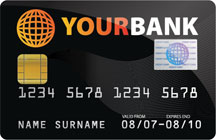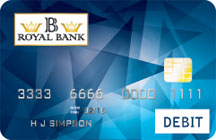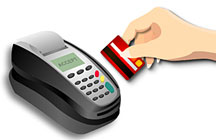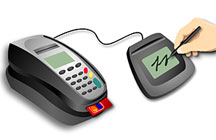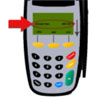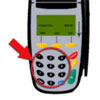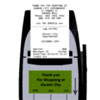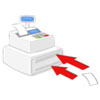- -Able to receive and process customer payments using cash, credit cards, EFTPOS.
-
Process Payments
Click on the Play button to start the introduction video.
-
Show Me!
Show Me!
Financial TransactionsClick on the Play button to start the video.
Customers expect a range of options when making payments, such as:
- cash
- cheques
- credit card or debit card
- EFTPOS
- travellers' cheques
The three main forms used are cash, credit or debit card, EFTPOS.
If you are handling cash:
- it needs to be secure at all times.
- follow the security procedures for your establishment.
Customers should always be given a receipt for each transaction.
Show Me!
Customers may pay for their food or a particular service in cash.
Handling Cash
- Mistakes need to be avoided.
- Mistakes cost stores money and upset customers.
- Each establishment will have procedures for handling cash.
Standard Procedures
1 Enter the price of each item into the register, or use the pre-set key or item code. 2 Sub-total the sale and tell the customer the total amount. 3 Call the amount of money given by the customer. 4 Place the money given on the register (not in the drawer yet). 5 Ring up the amount given on the Cash Total Button. 6 Make up the change and count it back to the customer. 7 Place the amount given into the cash drawer. 8 Close the cash drawer. 9 Hand the receipt to the customer. Customers who make payment in cash are entitled to the correct amount of change.
Remember: Correct change = Amount Paid minus Cost
Where electronic points of sale systems or cash registers are used, the amount of change is shown on the screen.
Show Me!
Transactions Using CardsClick on the Play button to start the video.
Paying with plastic cards is very popular. It means that people do not have to carry a lot of cash around.
Debit cards
- A debit card is issued by a bank.
- A debit card gives you direct access to the funds you have in your own account.
- With debit card transactions, your bank balance goes down.
- When debit cards are used as a form of payment a PIN, or Personal Identification Number, is required.
- The PIN is secret and is used to authenticate the user to a system.
Credit cards
- A credit card is a line of credit that is not linked to your bank account.
- When you make a purchase with your credit card, you are borrowing money for the purchase.
- You are not using money that is in your own bank account.
- When using a credit card as a form of payment, the customer can choose to:
- use a PIN.
- sign for the purchase.
- If a signature is used, it should be checked with the signature on the back of the credit card.
EFTPOS:
- stands for Electronic Funds Transfer at Point of Sale.
- allows the customer to use three different types of accounts.
- Savings: requires a PIN
- Cheque: requires a PIN
- Credit: requires a PIN or signature
- If a signature is used, it should be checked with the signature on the back of the credit card.
EFTPOS Procedures
- Insert or swipe the card and wait for processing.
- Ask the customer to press savings, cheque or credit.
- Check that the amount is correct.
- Ask the customer to enter PIN or sign.
- When approved, give the printout to the customer.
- Place the store copy in the correct section of the register.
-
Say It
There are 2 parts in this section.
1. The GlossaryThe glossary lists the more difficult words related to the topic in alphabetical order. The glossary also gives the meaning for each word.
2. Look, Cover, Write, Check!This activity gives you practice at remembering and writing the words from the glossary.
The Glossary
-
Do It: Process Payments
These days, customers expect a range of options when conducting financial transactions. As a tourism or hospitality industry employee, you need to know all forms of payment that are appropriate for your business and customers. Forms of payment accepted by your business may include cash, cheques, credit card, EFTPOS and travellers' cheques.
The main three forms of payment we will focus on are cash, credit card/debit card and EFTPOS payments.
If you are responsible for handling payments, it is your responsibility to ensure that the cash is secure at all times. Always follow the security procedures of your establishment.
Depending on the method of payment used by guests or customers, you may not always be required to give change. However, you should always give the guests or customers a receipt for each transaction.
Jump to ActivitiesDo It: Receiving and Processing Cash Transactions
1 Enter the price of each item into the register or use the pre-set key or item code. 2 Sub-total the sale and tell the customer the total amount. 3 Call the amount of money given by the customer. 4 Place the money given on the register (not in the drawer yet). 5 Ring up the amount given on the Cash Total Button. 6 Make up the change and count it back to the customer. 7 Place the amount into the cash drawer. 8 Close the cash drawer. 9 Hand the receipt to the customer. Customers and guests may pay for their food or a particular service in cash. Handling cash is an important part of your work. Here, mistakes can often be made and this needs to be avoided. It can cost the store money and upset customers.
Your establishment will have a set of procedures that you should observe when handling cash transactions. The table to the right outlines some of these standard procedures.
Do It: Differences between Credit Cards and Debit Cards
When purchasing with plastic you're often asked if you'd like to make it a debit or credit transaction. Credit and debit cards not only look identical, but they can be used at almost all the same places. There is a difference between the two cards.
A debit card is a card issued by a bank and the card gives you access to the funds you have in the account the card is associated with. This gives you direct access to your money. With every debit card transaction, your bank balance goes down, unlike credit cards. When debit cards are used as a form of payment, a PIN, which is a personal identification number is required. This number is a secret and is used to authenticate the user to a system.
A credit card is a line of credit that is not linked to your bank account. When you make a purchase with your credit card, you are essentially borrowing money for the purchase. Unlike with debit cards, you are not using money that is in your bank account. When using a credit card as a form of payment, the customer can choose to use a PIN or sign for the purchase. If a signature is provided, make sure to check that it matches the signature on the back of the credit card.
Do It: Receiving and Processing EFTPOS Transactions
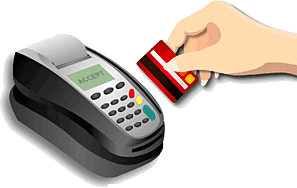
EFTPOS stands for Electronic Funds Transfer at Point of Sale. EFTPOS allows the customer the option of using three different types of accounts - Savings, Cheque or Credit. When savings or cheque accounts are selected, the customer is required to enter a PIN. If a customer or guest chooses the credit account option, they can either enter a PIN or supply a signature for the transaction.
When a customer wishes to pay using EFTPOS, there are some basic steps that should be followed. These include:
- Insert or swipe the card in the EFTPOS machine and wait for processing
- Ask the customer to press Saving, Cheque or Credit to select the account type
- Check that the amount is correct
- Ask the customer to enter PIN or sign (if needed)
- When approved, give the print out to the customer
- Place the store copy in the correct section of the register
Check It
Process Payments
- Introduction
- Show Me
- Say It
- Do It
- Check It











